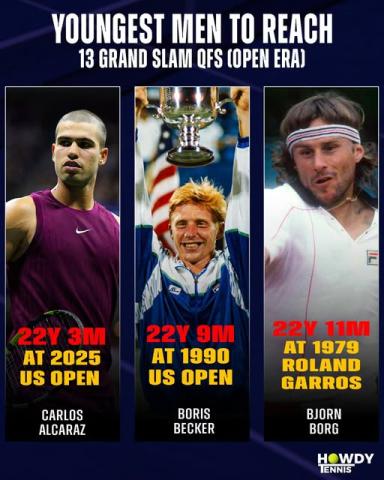
In the relentless, grinding theater of professional tennis, where careers are measured in Grand Slam triumphs and weeks at the summit, a rare breed of player operates on a different timeline. They don’t just break records; they shatter the very notion of what is possible for their age. Carlos Alcaraz, with his commanding run to the 2025 US Open quarterfinals, has now firmly embedded his name into this most exclusive of lists, becoming the youngest man in the Open Era to reach 13 major quarterfinals.
At just 22 years and 3 months, the Spanish phenom has surpassed the pace of two of the game’s most iconic youthful champions: Germany’s Boris Becker and Sweden’s ice-cool legend, Bjorn Borg. This isn’t just a statistic; it is a powerful testament to a precocity that borders on the supernatural, a consistency that defies the normal pressures of youth.
The Past: The Pioneers of Preccocity
To understand the magnitude of Alcaraz’s achievement, one must look back at the giants whose records he is now eclipsing.
- Bjorn Borg (22 years, 11 months): The original teen sensation. Borg’s achievement, set at the 1979 French Open, was a product of his otherworldly dominance on clay. He was a force of nature who seemed to play the game from a different dimension, his baseline prowess and mental fortitude rewriting the rules of what a young player could achieve. His record stood as a benchmark for generations.
- Boris Becker (22 years, 9 months): “Boom Boom” Becker announced himself to the world by winning Wimbledon at 17, a hurricane of power, volleys, and sheer audacity. His record, set at the 1990 US Open, reflected a player who lived for the biggest stages from the moment he turned professional. His game was built on explosive, high-risk tennis that translated immediately to the sport’s grandest arenas.
These were not merely great players; they were prodigies who compressed a decade of learning into a few short years, forcing the tennis world to kneel at their youth.
The Present: The Alcaraz Acceleration
Now, enter Carlos Alcaraz. His journey to 13 quarterfinals at an even younger age is a modern marvel, achieved in a far deeper, more physically demanding era.
Borg’s and Becker’s eras were legendary, but the modern game is a globalized, power-based assault from the baseline. The competition is fiercer, the athletes are stronger, and the calendar is unrelenting. For Alcaraz to not only survive but thrive, accumulating quarterfinal appearances at this blistering pace, speaks to a more complete and adaptable game from a younger age.
What separates Alcaraz is his terrifyingly complete toolbox. He possesses Borg’s competitive fire and baseline resilience, fused with Becker’s explosive power and net-rushing courage. But he adds layers they never needed: a Djokovic-like elasticity, a Nadal-like ferocity on defense, and a creative, drop-shot-laden artistry that is entirely his own. He is winning on all surfaces, all year round, in an era of specialists.
More Than a Number: The Sign of Greatness
Reaching 13 quarterfinals is not just about winning a lot of matches. It is the ultimate proof of consistency at the highest level. It means navigating the landmines of early-round matches against hungry opponents with nothing to lose. It means managing pressure, expectations, and the physical toll of best-of-five-set tennis, year after year.
For Alcaraz, this milestone is a confirmation. It silences any fleeting doubt that his early Grand Slam wins were a flash of brilliance. Instead, it paints the picture of a career built on a rock-solid foundation of excellence. It proves he is not a comet, but a sun—a constant, radiating force around which the rest of the tour must orbit.
The history of tennis is a story of evolution, each generation standing on the shoulders of the last. Bjorn Borg showed the world the power of icy determination. Boris Becker proved that youthful fearlessness could conquer Centre Court. Now, Carlos Alcaraz has taken their blueprint and accelerated it, combining the best of the past with the athleticism of the present.
He is not just following in the footsteps of giants; he is already walking beside them, and at 22, his journey has only just begun.
